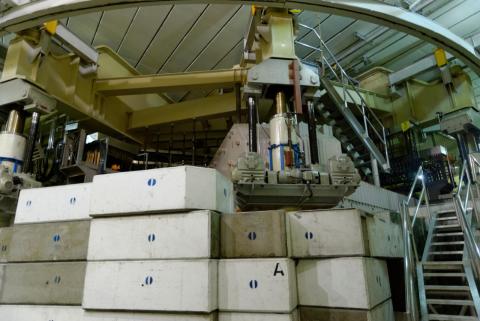
Spring is in the air. Daffodils are blooming, birds are singing and the world’s largest cyclotron is once again preparing to produce protons and accelerate beams to incredible speeds, breaking new ground in the study of rare isotopes. As part of the annual Systematic Approach to Shutdown (SAS), the cyclotron has lain dormant since January while crews work to update and maintain the 40 year-old particle accelerator and the many systems that help operate it.
“There are thousands of maintenance tasks that took place during the cyclotron shutdown period,” explains Yuri Bylinsky, Department Head of Accelerator Systems. After months of cable pulls, safety upgrades and general maintenance; TRIUMF’s workhorse cyclotron is refreshed for another season of safe and reliable proton beam delivery.
At 28 meters in diameter, TRIUMF’s 500 MeV cyclotron is the largest in the world. Located beneath three floors of concrete in the aptly named Cyclotron Vault, the cyclotron is radioactive during operation. However, unlike a nuclear reactor in a power station, the cyclotron essentially operates on an on/off switch. “Once the cyclotron has been shutdown for a few weeks, the background levels of radiation diminish and we can safely perform essential maintenance,” says Yuri.
One of the key upgrades this season was to install new platforms and handrails around the main cyclotron. Grant Minor, Nuclear Engineer and Group Leader of Remote Handling, enlisted his team of engineers to design a one-of-a-kind safety platform for a one-of-a-kind cyclotron. The platforms have been installed around the top magnet sectors of the cyclotron thereby providing another safe location for staff to perform maintenance.
The shutdown period also provides the opportunity to perform essential maintenance on equipment besides the main cyclotron. In addition to the 500 MeV cyclotron, TRIUMF also operates many smaller particle accelerators on site. The superconducting linear accelerator, or Linac, accelerates rare isotopes created by the main cyclotron’s beam to the speeds and energies required by the ISAC-II experiments, such as TIGRESS, IRIS and the soon-to-be operational EMMA.
The Linac is a large and complex machine and its maintenance checklist usually involves specialized key tasks; notably the niobium crystals that form the base for the superconducting magnets need to be “etched” periodically in order to purify them, and the cryomodules that help to cool the cavities close to absolute zero need constant upkeep. Etching the niobium crystals involves removing them from the accelerator cavities and placing them in an acid bath to remove any surface imperfections, what’s left is the super-pure niobium. Etching is required to keep the superconducting magnets in the particle accelerator working at peak performance.
“Etching the niobium crystals is done nearly every shutdown,” explains Bob Laxdal, department head of the SRF group in the accelerator division. “This shutdown, an additional task we’ve taken on was to seal a leak on one of the cryomodules of the Linac.” The cryomodules within the Linac accelerator cavities employ a layer of liquid helium, cooled to just 4 degrees above absolute zero, to insulate the cold magnets and shield them from the heat of the laboratory. “There was a small helium leak on one of these cavities that we had been keeping an eye on for years that we’ve finally managed to seal. I’m proud of my team for their exceptional work.”
In addition to the maintenance tasks and upgrades, the cyclotron shutdown period also provides valuable time for the preparation for new experiments and the installation of new equipment elsewhere on site while the “main magnet” is off.
Researchers focused on the Ultra-Cold Neutrons (UCN) project have been making way, moving both shielding blocks and existing beamlines in the Meson Hall in order to install a new beamline that will eventually produce these ultra-cold neutrons. The UCN group dedicated most of this shutdown period towards the decommissioning and removal of the M13 beamline, which once faithfully carried beam within the Meson Hall. In its place will go a section of the beam lines that will house a spallaion target to produce fast neutrons. These fast neutrons will then need to be cooled in order to be used in UCN experiments. Commissioning of the UCN facility is on track for completion in 2017.
Teams at TRIUMF have worked very hard to ensure that the cyclotron can safely and reliably continue supporting ground breaking research for many more years to come. The cyclotron is expected to be fully operational later this spring.
–Christopher Zaworski, Outreach & Communications Assistant


When it is safe to do so, crews can go into the cyclotron to do maintenance.


The mechanisms that lift and lower the cyclotron can be seen here, as well as the orange magnet and a beamline leaving the cyclotron.


Some of the new cables installed this season as part of the cable pulls.
